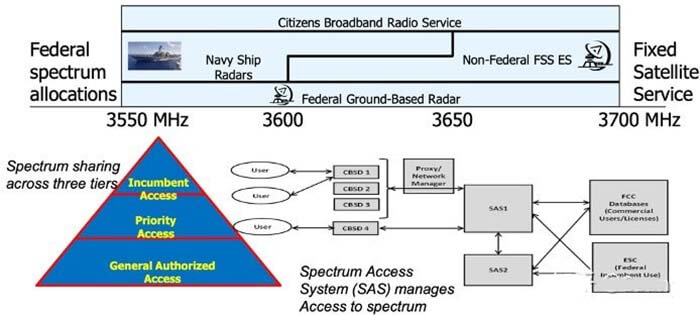
What is a 3.5GHz CBRS band?
3.5GHz CBRS is the abbreviation of Citizens Broadband Radio Service.
The bandwidth of the 3.5GHz CBRS spectrum is 150MHz, the range of the 3.5GHz CBRS spectrum is 3550 to 3700MHz, and the frequency allocation spans the existing LTE band 42 (3400 MHz to 3600 MHz) and LTE band 43 (3600 MHz to 3800 MHz).
Here we present the FCC’s specific case in the midrange 3.5GHz CBRS band allocation.
This case is the 3.5GHz CBRS (Citizen Broadband Radio Service) band that just completed the spectrum auction and harvested $4.58 billion.
- The 3.5GHz band has been identified by the U.S. government in 2010 as a new frequency band for civilian use, 8 years before the commercialization of 5G in the same band, but the auction was not completed until 2020.
- 3.5GHz CBRS is a major innovation in three-tier spectrum sharing. This system is designed to ensure that existing government users (DoD/Navy radar) have the highest authority over the spectrum. The details of how it works will be discussed later.
- In 2018 the FCC completed specific rules for the license that broadened the bandwidth, extended the validity period, and significantly increased the value of the license.
The determination of these rules is what finally made operators (AT&T, Verizon, etc.) and equipment manufacturers (Apple, Samsung, etc.) determined to invest in supporting this new band
- The total price of the 70MHz CRBRS spectrum in this auction is 4.58 billion, which is less than the previous bands of similar bandwidth at 700MHz (19.3 billion/70MHz) and 1.9GHz (44.9 billion/65MHz).
Why is the 3.5GHz CBRS band not selling well?
The question you may be most confused about is why it took so long for the US to open this new band and why this 3.5GHz CBRS new band, which can be used for 5G, is not selling at a good price. There are several reasons.
- Spectrum allocation and demolition work are similar. And this demolition is the U.S. Navy their building, with the Navy’s arrogant temperament, as well as the speed of its technology iteration, naturally will not take the initiative to cooperate with the work of other departments.
Technically speaking, if the civilian launch power is too high, it will lead to interference with the Navy’s radar, which in turn will affect national security, so the government is also cautious.
- The 3.5GHz CBRS new three-tier spectrum sharing system is technically very complex, resulting in excessive time spent on the commercialization of the technology.
How this 3.5GHz CBRS system works can be compared to a new civilian user who wants to occupy a DoD/Navy building (spectrum) but is only allowed to use it when the old user is not in the building (warships do not come ashore).
Then in order to detect if the old user is in or out and the new user is qualified, a set of sensors and a security system are needed. This security system is the spectrum access system server (SAS), with Environmental Sensing Capability (ESC) to detect whether there are warships near the coast and dynamic allocation of spectrum.
The following figure is the FCC’s description of this system:

The top of the three-tier structure, Incumbent Access, or existing Navy radar users, have the highest access to the spectrum and are the ones protected by the new system.
The second tier is Priority Access, which is the user of this auction license.
The third layer is General Authorized Access, similar to Wifi hotspot providers because no license does not guarantee the quality of communication.
We can imagine how many complex technical issues this system has to solve, whether the spectrum access system is reliable and whether it can guarantee the normal use of ordinary users.
What is the upper limit of transmitting power for ordinary users to ensure that naval radars are not affected; whether there is a possibility of shore-based sensors being attacked, leading to the exposure of warship locations, etc. A lot of time was spent by industry to solve these problems.
- The license provided by this system is different from the traditional license, which is dynamically assigned by SAS, not an exclusive license that can be bought and used at will.
Operators and equipment vendors have to get SAS licenses first, which is equivalent to an additional layer of intermediaries, so it is natural to question this system.
The traditional vendors such as Nokia, Qualcomm, and Verizon oppose this three-tier structure, but the new player Google highly recommends this three-tier structure and has built a prototype of SAS, aiming to expand its own carrier business and expand its voice in the wireless field. This entanglement of interests further hindered the process of spectrum allocation
- The emergence of 5G technology has led the industry to revisit the way this band is used.
As you can see from the timeline, the U.S. planning for this band prior to 2018 was to provide a maximum of 40MHz of bandwidth, and it was very fragmented, without the entire County-level license.
This is a drop in the bucket for the massive deployment of 5G at 100MHz bandwidth at every turn, citywide and provincewide.
For this band, which was originally planned for 4G LTE, the government had to spend time increasing the bandwidth, and the validity of the license. But the adjusted bandwidth of 70MHz makes this band still unattractive and the price is greatly reduced.
3.5GHz CRBS band in the United States because of its unique three-tier spectrum sharing system, the full reuse of existing frequency bands to improve spectrum utilization, once known as the innovative band, but because of its commercialization time is too long, gradually replaced by the new communication technology 5G NR.
Besides this What is the 3.5GHz CBRS Band article, you may also be interested in the below articles.
What is the difference between WIFI and WLAN?
Summary of 41 Basic Knowledge of LTE
What Is The 5G Network Slicing?
